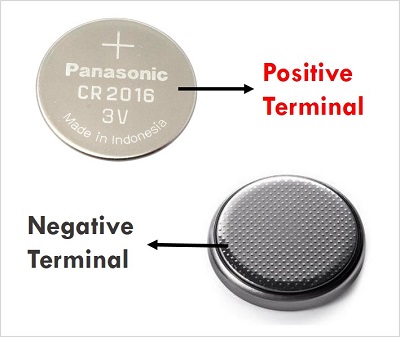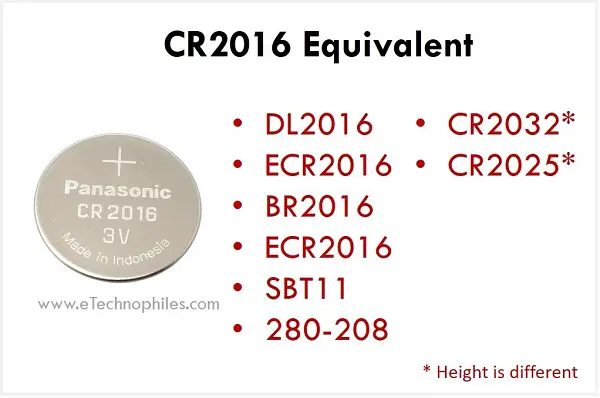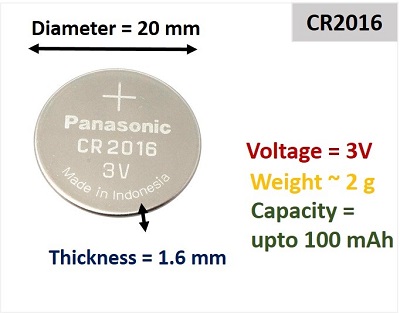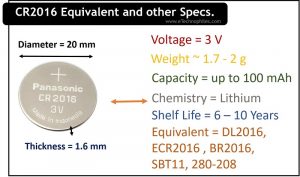Last updated on April 3rd, 2024 at 12:24 pm
It is a primary lithium coin battery that has a nominal voltage of 3V, a typical capacity of 100 mAh, and is 20 mm in diameter and 1.6 mm in height. It has a shelf life of 6-10 years when stored at room temperature which decreases to 3-5 years when stored at high temperatures.
This can be used as replacements for the following: DL2016, BR2016, 280-208, ECR2016, and SBT11. All these batteries are 3 volts and have a diameter and height of 20 mm and 1.6 mm respectively.
These batteries are found in a wide range of electronic devices, automotive applications, sensors, fitness appliances, and medical thermometers.
Table of Contents
What does CR2016 stand for?
CR2016 stands for a lithium manganese dioxide battery (round shape) having a 20mm diameter and 1.6mm thickness.
- The letter C indicates the chemical composition used in the battery (here ie, Lithium Manganese Dioxide)
- The letter R indicates the shape of the battery (here ie, Round)
- The first two digits indicate the battery’s diameter in millimeters (here ie. 20mm)
- The second two digits indicate the battery’s thickness (here ie. 1.6mm)
What is a CR2016 battery?
The CR2016 is a tiny, circular lithium coin battery. It’s based on a lithium/manganese dioxide (Li/MnO2) chemistry. It’s a tiny, lightweight ultra-compact battery that fits easily onto small gadgets like car remote keys, timepieces, calculators, and other similar gadgets.
It is easy to recognize the terminals of this battery. The rough texture end is the negative terminal and the opposite flat surface is the positive terminal which is indicated on the battery as ‘+’.

Generally, these batteries have an operating temperature that ranges between -20℃ (-4℉) and 70°C (158°F), with a typical power capacity of approximately 90-100 mAh. They also have a maximum continuous discharge current of 1 mA, a nominal discharge current of 0.1 mA, and a maximum pulse current in the 5 mA and 15 mAh range.
The main advantage of CR2016 batteries is that they have a long shelf life, up to 10 years.
CR2016 equivalent batteries

The CR2016 can be easily replaced with DL2016, ECR2016, BR2016, DL2016B, BR2016-1W, CR2016-1W, 280-208, ECR2016, SBT11, and KCR2016. Each battery in this list has the same height, diameter, and voltage.
CR2032 and CR2025 are considered the best equivalent batteries to CR2016. Though the voltage and diameter are the same, the heights of CR2032 and CR2025 are 3.2 mm and 2.5 mm respectively.
Some other equivalent CR2016 batteries are CR2025, CR1632, CR1620, CR1616, CR1220, and CR1216. But keep in mind that you will have to make some mechanical adjustments to use one of these in place of CR2032.
Note: While replacing a cell with a similar one, do not just stick to its size. It may fit the slot, but the voltage and power output must match the device’s requirements. Otherwise, it can cause severe damage to the system due to over/under discharge.
Specifications

The table given below lists the important features of a CR2016 battery.
| Battery type | Lithium coin |
| Chemical System | lithium/manganese dioxide (Li/MnO2) |
| Nominal Voltage | 3 V |
| Diameter | 20 mm (0.787 inches) |
| Thickness | 1.6 mm |
| Nominal Capacity | up to 100 mAh |
| Weight | 1.7 – 2 g |
| Operating Temperature | -20 ˚C to 70 ˚C |
| Standard Discharge Current | 0.1 mA |
| Shelf life | 6-10 years |
| Battery Manufacturer Brands | Murata, Toshiba, Energizer, Maxell, Renata, Panasonic, and More |
The nominal voltage of this battery is 3V. It weighs 1.6g and is 20mm in diameter and 1.6 mm in height.
Applications
It is commonly used in watches, calculators, and other small electronic devices. This battery is known for its long life and high energy density, making it an ideal choice for applications where those qualities are important. The battery is also relatively inexpensive, making it a popular choice for budget-conscious consumers.
These batteries are mostly used in:
- Small PDA devices
- Wireless doorbell for house
- Electronic Toys
- Portable electronics
- Digital thermometers
- Digital altimeter
- Heart rate monitors
- Digital watch
- Automobile applications (smart key, keyless entry, etc.)
- Laser pens
- CMOS memory backups
- Memory cards
- Fitness applications
- Medical devices
- Calculators
CR2016 Shelf Life
The shelf life of a CR2016 battery is 6 to 10 years.
Even when in use, the life of CR2016 can go up to 7 years for applications like watches, if you don’t utilize the auto EL light function, the hourly chime, or the alarm.
As per watch manuals, battery life for this battery is typically around 2 years, especially one from G-Shock watches.
Datasheet
Detailed specs can be found in the datasheet. It is always advisable to check the manufacturer’s datasheet before using the battery.
Download the CR2016 battery datasheet from here(omnergy) or here(Energizer)
FAQs
What are the benefits of the CR2016 battery?
1. Long shelf life
2. Wide temperature range
3. High energy density
4. Excellent discharge characteristics
5. High Capacity
Are all CR2016 batteries the same?
No, Although all CR2016 batteries have the same chemistry and physical dimensions, they can vary in terms of actual capacity, discharge characteristics, self-discharge rate, operational temperature range, and other factors.
Is the CR2016 battery rechargeable?
No, once it dies it needs to be replaced
How many volts should a CR2016 battery have?
The nominal voltage of the CR2016 battery is 3V. During normal operation, the voltage drops down to 2.7-2.8 volts and when the battery is almost discharged, the voltage sharply drops down to 2.0 volts.
